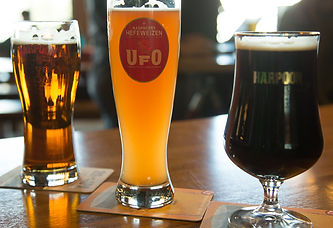Beertionary
Whether you are new to beer or have simply always wondered what "hops" really are, let this beer dictionary (Beertionary) help you keep up with the beer experts.
a beer brewed using top fermenting yeast; typically fermented at warmer temperatures than lagers and served warmer
Ale
a major cereal grain; important uses include use as animal fodder, as a source of fermentable material for beer and certain distilled beverages
Barley
pale ale beers brewed with crystal malt (malt that is roasted before using it in the fabrication of beer); hops are usually used in a small amount in amber beers
Amber
the particular combination of smells from malt, hops, yeast, and any unusual or distinctive disturbances in the beer
Aroma
Beer
an alcoholic drink made from yeast-fermented malt flavored with hops
Body
thickness or “mouth-feeling” property of a beer, ranges from thin- to full-bodied
a person that supervises the brewing in a brewery; typically a “beer expert”
Brewmaster
Brewpub
a bar or pub that brews its own beer and sells a minimum of 25% of it on site
Carbonation
(v.) the introduction of carbon dioxide to the beer; (n.) the presence of carbon dioxide bubbles in beer, created during fermentation or introduced independently through “forced carbonation”
Color
the hue or shade of beer, can be derived from wheat or additional ingredients such as fruit
beer that was made in a small and independent brewery. In order to be considered “craft beer” it has to be brew by a company that has a production of less than 700,000,000 L.
Craft Beer
beer that is served from kegs or tanks rather than from individual bottles or cans
Draught Beer/Draft
the process by which yeast converts glucose into ethyl alcohol and carbon dioxide gas, giving the beer both its alcohol content and its carbonation
Ferment
a container, cylindrical in shape, often made of steel or aluminum that is used to store, transport, and serve beer; in the United States a keg contains a half-barrel (15.5 US gallons) of beer
Keg
making beer at home; legalized in the United States by the “Cranston Bill” on February 1, 1979 by President Jimmy Carter; allows a single person to brew up to 100 gallons of beer annually for personal enjoyment and up to 200 gallons in a household of two persons or more of legal drinking age
Home Brewing
the soft-leaved, pinecone-like flower of a vine plant responsible for the bitterness, aroma, and flavor in beer
• added at three stages of the boiling process: beginning (for
bitterness), middle (for flavor), and end (for aroma)
• inhibits the growth of bacteria in the wort
Hops
beer made with pale malt and a very strong concentration of hops.; originally from England, crafted for exportation to India
IPA or India Pale Ale
a beer that is effervescent and light in color and body
Lager
the process of separating the sweet wort from the spent grains in a large vessel or with a straining device
Lautering
lager with reduced alcohol content
Light Beer
another term for bottled beer
Longneck
barley or other grain that has been steeped, germinated, and dried
Malt
also referred to as honey wine, brewed with a solution of water, honey, and grain mash
Mead
a brewery that typically produces specialty and craft beers
Microbrewery
Milling
grinding the malt into grist (meal) to facilitate the extraction of sugars and other soluble substances during the mash process; the husks should remain intact when the grain is milled so they later act as a filter aid during lautering
a pale larger or gold colored beer characterized by its light color and stability; brewed using noble hops, with less bitterness, and soft water; has an alcohol concentration of 5 percent and it is the number one consumed beer in the world
Pilsner
the refuse of solid matter that settles and accumulates at the bottom of fermenters, conditioning vessels, and bottles of bottle-conditioned beer
Sediment
a beer brewed with a high concentration of wheat malted barley
Wheat Ale
the bittersweet sugar solution obtained by mashing malt and boiling in the hops
Wort
key to the fermenting process; converts the malt sugars into alcohol and carbon dioxide in the beer
Yeast





Barley
Color varies depending on the type of beer.
Malt of the chocolate variety.
A homebrewer bottling his own beer.
Longnecks, or bottled beer.

Taking in the aroma of beer samples.
Sources: BeerAdvocate, Brewin' with Herb, CraftBeer.com, and Merriam-Webster
